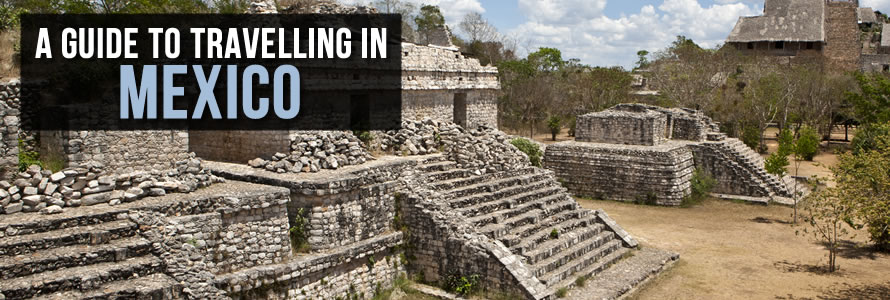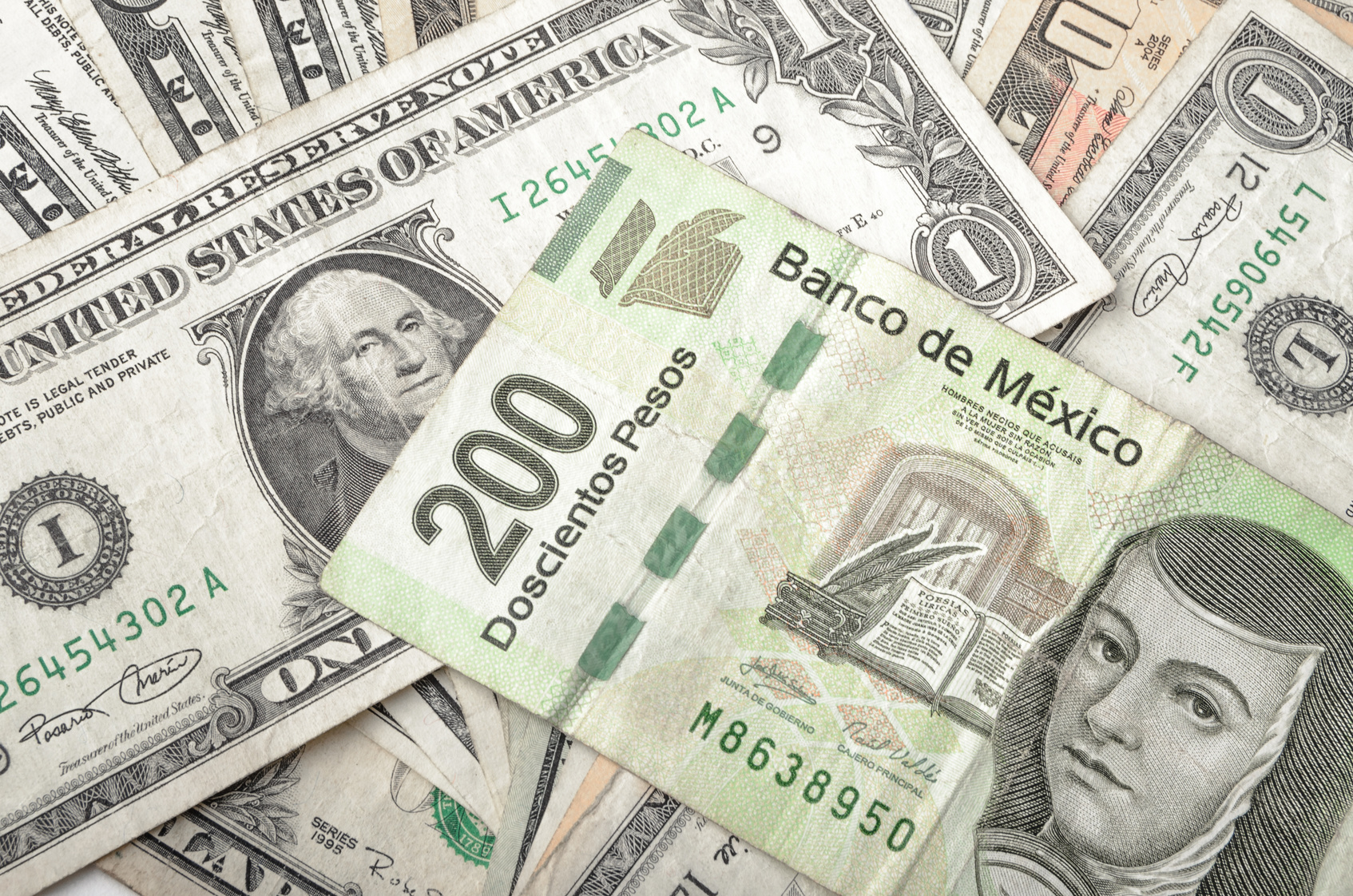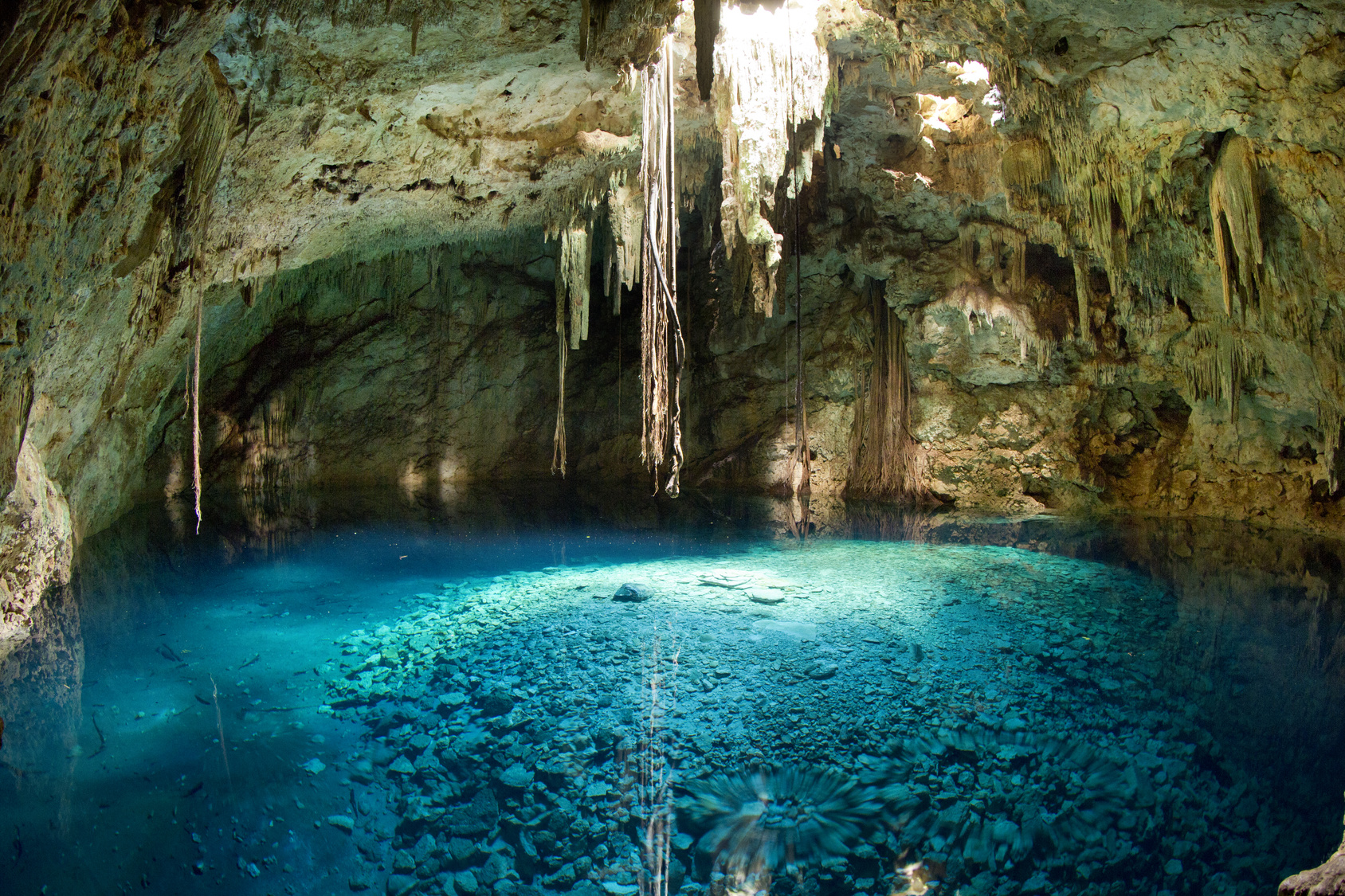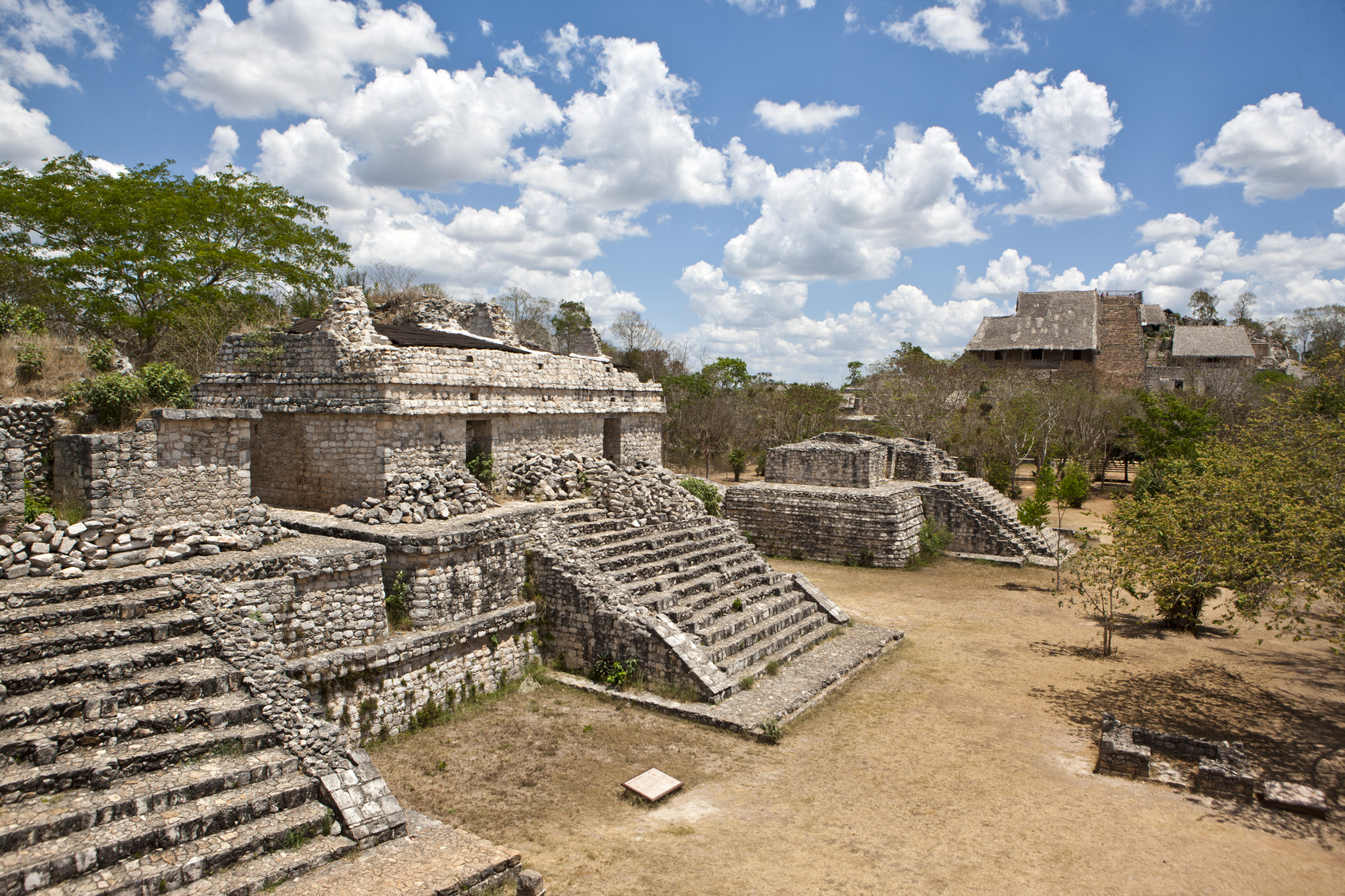Mexico is technically and geographically part of North America, but anyone who has visited here will tell you it is Latino through and through. Many seem to give it a miss on the backpacker circuit – heading instead to Mexico’s Latin cousins to the south in Central and South America. This bypassing is a mystery though because Mexico is crammed to bursting with things guaranteed to keep the world traveller and explorer happy, fascinated and amazed, not least of all because it is so vast. And there’s more. Mexicans are exceptionally welcoming to their visitors, costs are backpacker friendly and the food is as good as it gets anywhere on Earth with an almost mind-boggling diversity of flavours and styles.
The country’s beaches tend to rank highly in the tropically idyllic scale – especially those of the Caribbean coast and islands – while just about every kind of terrain known to man is represented somewhere in the country including mountains, desert and jungle. Mexico also happens to claim for its own some things you won’t find anywhere else such as the magical, blue-pooled cenotes of the Yucatan Peninsula or the Naica Mine with its caves of crystals – the biggest ever found anywhere.
You also need to factor in the lovely and usually rainbow-hued Spanish colonial towns and cities, more Mayan sites of global significance than you could get round in one trip, some colourful and highly fascinating indigenous cultures and a land which tells its story – ancient and modern – through music and dance; both of the latter run through this wonderful country like blood through veins and can be stumbled upon almost everywhere you go. No matter what kind of experience you personally define as a must-do part of your backpacker journey the chances are Mexico can deliver…and then some.
Visa Requirements
For the lucky citizens of 65 countries (which include Canada, the USA, the EU, the UK, New Zealand and Australia) in order to get up to 180 days in Mexico as a visitor or tourist all you have to do is turn up at the Mexican border or land at an airport. You will be stamped at immigration and that’s it. Occasionally, immigration officials will ask to see proof of onward travel (bus or plane ticket) and you might be refused entry if you can’t show it.
Climate – A Little Bit of Everything
Mexico is huge and covers many degrees of latitude of the globe. It also has very high places as well as beaches and deserts; factor into that the two coastlines, each sporting their own distinct and different weather patterns. This all adds up to an enormous range of possibilities with regard to the weather and even individual destinations might have a variety of climates depending on the time of year. You will need to do a bit of research in advance if you want to know the type of clothes you are likely to need and what weather and temperature ranges to expect for when and where you are travelling.
How Safe is Mexico?
If you talk to someone from the United States (who has never been to Mexico) you will probably come away thinking Mexico is the biggest den of iniquity and danger on the entire planet. Mexico, does seem to suffer – inexplicably at times and highly unfairly – from a general reputation as dodgy, but interestingly (and to get some perspective here) the assault rate in the US is much higher than in Mexico. Mexico City is statistically four times safer than Washington DC while the Yucatan region of Mexico ranks as one of the safest of all the Caribbean regions.
Without doubt there are places in Mexico where it is unwise to stray – the US/Mexico border areas are sometimes on this list – but that is also true of the United States, parts of British cities and probably just about every country in the world. Mexico is vast (think we might have said that before) and there are many many places which are as safe as anywhere else. Simply follow the normal rule of thumb – always ask your fellow travellers, hostel staff or locals for advice of potential dangers and pitfalls when rocking up somewhere new and follow it. The off limit places in Mexico tend to move and change depending on what is going on politically at the time while the big cities will always need a little extra caution. In short, do a little homework, ask for advice and follow the usual responsible and aware traveller’s tenets and you’ll stay safe and trouble free.
Accommodation Choices
Hostels – the backpackers’ number 1 budget accommodation choice – are everywhere in Mexico. As is true of hostels almost anywhere, they come in all shapes and sizes with a variety of standards, value for money, facilities and atmosphere but there are some real crackers in Mexico – even in the most remote or off-the-beaten-path places. There is an ever growing choice of ‘flash-packers’ for those who want a little more comfort while cheap guest houses and budget hotels are also common. Additionally, there is a large Couch Surfing community in Mexico, so if you want to go down this route you shouldn’t have too many problems finding a host.
Mexican Food & Drink – A Major Delight
While the rest of Latin America tends to dish up so-so fare, Mexico’s incredible delights are lauded across the globe. It is the undisputed culinary king of the whole continent and many would even say the world. This is a cuisine of 1001 tastes and flavours, of both the supremely subtle and explosively in-your-face and with more local specialities than you could get through in a lifetime. There are a few common dishes across the country but otherwise ‘Mexican’ food as such doesn’t really exist – everything is highly regional and varies accordingly. For example, in the north you are more likely to be eating goat while flavours around the east are often Caribbean influenced; head to the coast and of course seafood and fish are going to become more widely used.
Also, much of what you might think you know of as Mexican food is actually Tex-Mex and a little different to what you will actually find once you are here. Terms such as tortilla, taco, guacamole and enchilada you may well be familiar with but there will be tons of others you won’t. Outside of the biggest tourist hubs it is unlikely you will find menus in English so unless your Spanish is up to the mark you might want to prepare yourself or risk missing out big time on some of the country’s most amazing food choices.
Not only do the dishes themselves need translating but all the many different ways in which something can be cooked (barbecued, grilled, broiled, fried etc); these terms are often added onto a dish’s title and tell you instantly what something is. You WILL need a glossary unless you are happy to just take pot luck…..which might see you being served up fried grasshoppers (chapulines). These are actually delicious but some people are picky about these things. You might also want to do a little homework on chilli varieties. Some of the Mexican ones are blow-your-head-off hot.
The list of must-tries in Mexico with regard to food and drink could fill a book but some stand-out candidates are the following:
Mole – There are hundreds of different types of these super complex sauces which have at least 20 ingredients and often many more. Found everywhere but especially around Puebla and Oaxaca, moles almost always include chillies – both mild and scorching – while other ingredients can be nuts, seeds, herbs, vegetables, spices and chocolate. The latter is the base for the dark mole poblano and just in case you are thinking ‘chocolate sauce with my chicken? No thank you’, you should try it; the chocolate acts as a culinary balancer to the chilli heat rather than a flavouring and it somehow works wonderfully well.
Horchata – often just listed as a rice drink, no description of this heavenly beverage can ever prepare you for the taste. Some describe it as flowery, some insist it is the drink of the gods while many try it once and then find not a day in Mexico can go past without needing an horchata fix.
Sopa de Tortilla – a soup base, usually chicken, which might have any number of subtle or stronger flavourings going on. The avocado might be served separately or put into the soup while the tortilla strips get added just at the last minute to retain an incredible texture. The whole is usually cheese-topped and somehow far greater than the sum of its parts.
Mexico’s Languages
Interestingly there is no official language in Mexico but more than 60 are officially recognised. Most of these are indigenous languages and still used in more remote parts. However, the language you will almost certainly hear the most, and that used by the majority as a first language, is Spanish. Around the Yucatan and those places with higher tourist traffic you should find English spoken to some degree if not perhaps as widely as some might expect. Outside of the tourist areas you might not come across anyone who can speak English at all, even in hostels and guest-houses. As always, even if you have no intention of learning the language properly, equipping yourself with a few words and key phrases is going to make your travelling far richer and certainly easier to say nothing for showing a little courtesy to your host country.
Money Matters
Mexico’s currency is the peso and typically it is the only currency accepted anywhere in the country. If you are around tourist-central Cancun you might find places which will accept US dollars even though they are technically not supposed to. Credit and debit cards are also accepted widely in certain shops and restaurants while many hostels will take plastic payment too but cash is still king in this country and for the more local or smaller establishments is the only way to go. Money exchanges are common in larger towns and cities as are ATMs. This latter can often be found in even tiny places but that doesn’t mean they will always have any cash in them. If you are headed somewhere a little off the main trail be sure to stock up on some cash before heading out.
Transport Options in Mexico
Although you will find all kinds of local variations on transport options your three main choices for travel around Mexico are plane, bus and minivan shuttle.
Plane – As we might have already mentioned Mexico is enormous. Getting from region to region can entail gruellingly long journeys by road and the most comfortable buses can seem pricey. Thanks to some budget carriers, it is often as cheap in Mexico – and of course always way quicker – to get a flight if you really want to cover a large distance. Many of the domestic flight companies are not on the comparison or cheap flight finder sites such as Skyscanner and Kayak. Your best bet is to pop into a local travel agent to see what is on offer.
Bus – chicken buses – the converted and colourful US school buses you see everywhere – are always the cheapest way to go. Many who visit Mexico have a slightly romanticised view of travelling by chicken bus and nobody would question that they are the most authentic and culturally immersive way to go. However, the allure of authentic can wear off after hour upon hour in a rammed and hot chicken bus which seems to stop every 50 metres to pick up (and squeeze in) yet another passenger.
Save the (sometimes) fun chicken bus experience for the shorter journeys and opt for as comfortable as you can go on your budget for the longer journeys. There is a highly extensive network of long distance buses travelling the length and breadth of Mexico ranging from the acceptable to the luxurious and the direct to the multi-stop and often aimed, in the main, at the tourists and travellers.
It is worth noting that long distance buses in Mexico can seem a bit more expensive when compared with other Central American destinations (although they are often covering far longer distances). Additionally, some routes get super busy in high season and you might have to plan your journey and buy your ticket at least the day before travel and sometimes even more.
Shuttles – usually minivans, shuttle services are often door-to-door non-stop services which are almost always catering to the travellers’ market. These CAN often be booked directly from your hostel.
Mexico’s Major Highlights
You could travel Mexico for many gap years and still not be able to tick off all of its major highlights and must-see sights and experiences. Yes, we’ve mentioned it before – but Mexico is huge and every region has its own special list of somethings; in most cases many many somethings.
We have picked just a handful of what we consider to be the essential inclusions but there are literally hundreds and hundreds more.
Cenotes – part fairy grotto, part mystical paces of the Mayans, the stunningly magical cenotes of the Yucatan peninsula are thought to have some connection with the asteroid which landed in this region 65 million years ago and which many believe to have been responsible for wiping out the dinosaurs. Essentially underground pools of stunning colours, cenotes are sometimes adorned with stalactites and stalagmites and may have tree roots growing down from their roofs. Many come to these cool-watered places to swim and snorkel, some come to dive but all are blown away by their beauty.
Isla Holbox – Mexico has lots of lovely islands but several of them – certainly those closest to Cancun – are starting to look a little like Cancun in miniature. However, if you know where to head there are still several islands which have more Robinson Crusoe or chilled Caribbean vibe about them than Spring Break central. One such is enchanting little Holbox (pronounced Holbosh) which was once the resting place of pirates. Here you can feel the sand between your toes as you sip your sundown cocktail at the simple thatch beach bars and watch the flamingos, frigate birds and pelicans flying past.
Swimming with Whale Sharks – Whale sharks are the biggest fish on the planet and when we say big we mean enormous. There are a few other places in the world where you can swim with these gentle giants but nowhere on the planet do they congregate in the numbers they do in the waters off the Yucatan coast. Tours aplenty are up for grabs to get you swimming alongside or above these majestic creatures which luckily feed mainly on plankton so humans are off the menu.
An average whale shark will measure around the 10 metre mark but can grow up to 15 metres while the mouths (which they will have open wide as they swim towards you to feed) are around 1.5 metres across.
Whale shark season runs for a few months from around mid-May to mid-September and departures can be booked pretty much along the whole Caribbean side of Mexico’s coastal and island resorts and towns including Tulum, Cancun and Isla Mujeres.
Mayan Ruins – Mayan ruins are everywhere in Mexico. The most famous is Chichen Itza with its huge pyramid – now listed as one of the New Seven Wonders of the World. Impressive this pyramid is without a doubt but there are many who prefer some of the smaller and less tourist-crammed sites which are in reality far more atmospheric and where they can actually climb the pyramids and explore the ancient buildings up close. A run-down of the Mayan ruins of Mexico is a book in itself and you could easily base your whole trip around ‘collecting’ them. You’ll find plenty of info on all the larger sites and Tulum’s ruins are perennially popular – if almost always busy – because the turquoise ocean makes for a super-picturesque setting. However, a couple of lesser known sites which are really worth a visit are often deserted Ek Balam (which has its own cenote), the rainforest surrounded Calakmul where exotic toucans are regularly seen flying overhead and the jungle-located Kabah with its El Palacio wall made up of sky serpent god masks.
Lake Bacalar – there are few who can see pictures of this enchanting but little-visited lake and believe it is a lake rather than the ocean. Sitting towards the Belize border and known as the lake of seven colours, Bacalar’s colour spectrum magic comes courtesy of a dazzlingly white sand and limestone bottom over which lap crystal clear waters. The total effect – and one guaranteed to take your breath away – is a range of turquoises, aqua-marines, emeralds, lime greens and more while the shores are decorated with nodding coconut palms to complete the idyll.
There isn’t much to do at Bacalar – aside from the 16th century Spanish fort – but that is kind of why people come here. There are a handful of low-key huts and hostels – a couple right on the lake – at which to park yourself and just gaze. Alternatively you can paddle out on a kayak to the islands here and lose yourself in the whole dreamlike loveliness of it all.
San Cristobal de las Casas – Chiapas located San Cristobal de las Casas is somewhat remote and takes some getting to but every second of that is paid back to you a hundred times once you arrive. Essentially an incredibly well-preserved Spanish colonial town splashed with colour at every turn, enchanting San Cristobal is so much more and has an indefinable magic. Many come here for a day or two and are still here weeks or even months later.
Music and dance are everywhere – just trip your way along the town’s cobbled streets in the evening, especially the main walking street, and find without trying any number of performers both formal and informal. Festivals, fiestas and processions seem to be taking place in the streets constantly while beautiful handicrafts are a big thing too.
Climb the steps of one of the elevated churches for some sweeping views and be sure to check out the fascinating church at San Juan Chemula, a short trip from San Cristobal. This region is peopled with indigenous folk and the worshippers at San Juan church hold a mix of Christian and ancient religious beliefs. This pine-needle strewn church, which doesn’t allow photography, is where you will see the faithful praying in rituals which feature drinking coke, an occasional chicken sacrifice and almost certainly more candles than you will ever have seen in one place in your life. It is both bizarre and beautiful.
Día de los Muertos – Day of the Dead
Possibly one of the things Mexico is most well known for, Day of the Dead takes place between October 31st and November 2nd and is a traditional Mexican holiday. Mexicans honour their dead during this period, but it is by no means a bleak affair, Day of the Dead is an upbeat, colourful and festive celebration of deceased loved ones. Mexicans typically visit the graves of friends or relatives who have passed on, decorate their graves with colourful and traditional decorations and spend time in the presence of the dead. Another tradition is to create decorative alters (ofrendas) in their homes, which are said to welcome spirits. In 2016, Mexico City held their first ever Day of the Dead parade with giant floats, actors, dancers and giant skeleton marionettes.





